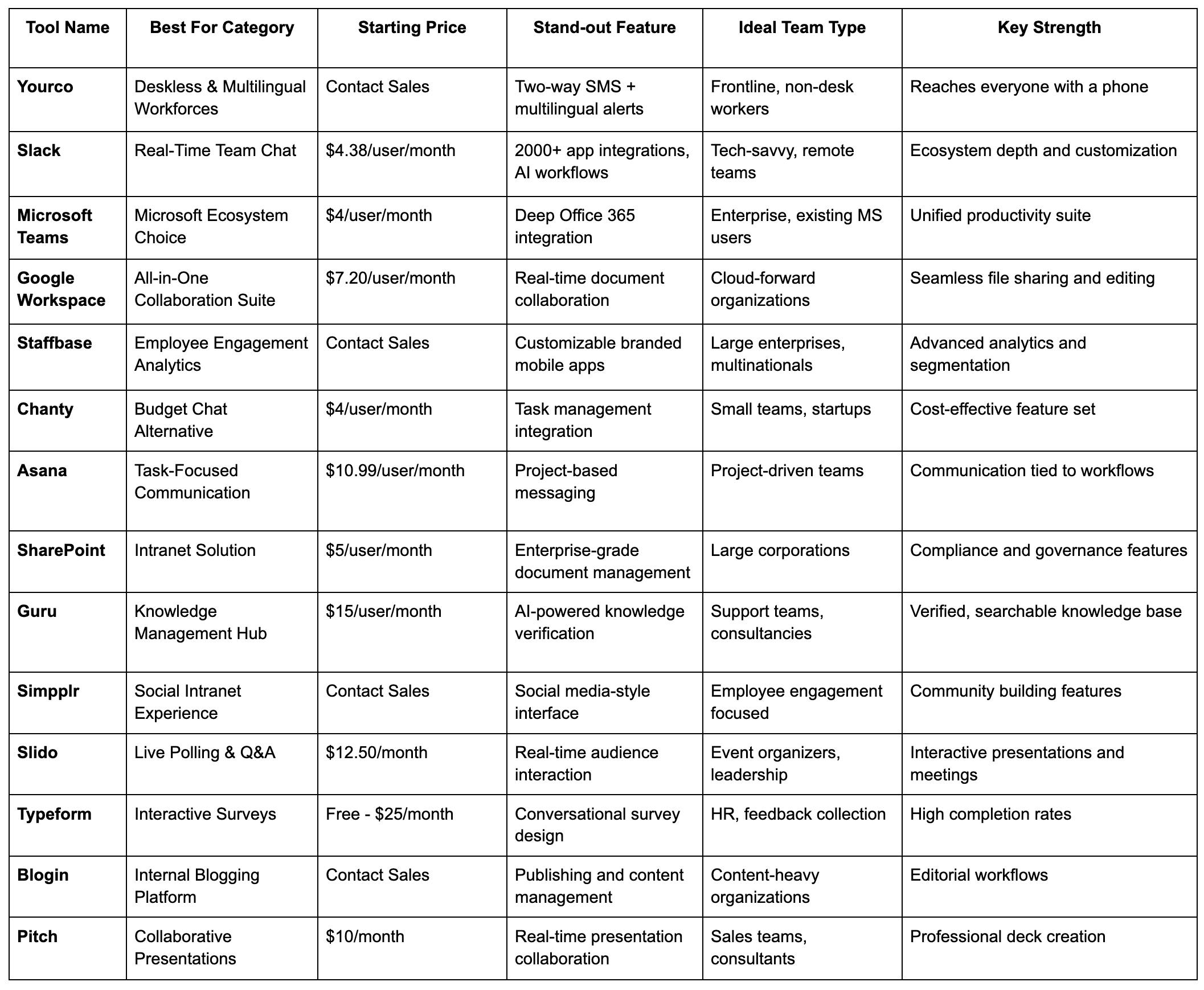Top Internal Communication Tools to Engage Employees


Internal communication is the backbone of every organization, from corporate HQs to field operations. Yet, while tech-savvy office workers may breeze through intranets, Slack threads, or Teams updates, millions of frontline employees are left out of the loop. Frontline employees are those employees who work without a desk; in fields, in factories, or shops and so on. These employees make up over 80% of the global workforce, but often feel ill-equipped to perform their job well due to bad communication and a lack of real-time information from their companies.
Whether your teams are behind desks, on the floor, out in the field, or distributed across time zones, the real challenge isn't just picking tools, it's choosing the right internal communication tools that actually reach your people, engage them, and keep them aligned. This guide will explore the top categories of internal communication software and how they serve diverse workforces, with a special focus on the overlooked but essential non-desk segment.
Challenges with Internal Communication Tools
Whether employees are in the office, remote, or hybrid, internal communication tools often fall short in a few predictable ways:
- Too many tools, too little clarity: With email, Slack, Zoom, project software, and HR portals all vying for attention, messages get lost or duplicated. Information silos and fragmented channels lead to confusion and disengagement.
- Information overload: Employees receive a firehose of messages every day. Without proper filtering or prioritization, important updates get buried under low-priority noise.
- Disconnection in mobile, hybrid and remote setups: Remote or mobile workers may struggle to feel part of the company culture, especially if internal communication lacks intention or visibility into broader initiatives.
- Cultural and language barriers make things worse in diverse workforces. Standard communications often ignore linguistic diversity, creating misunderstandings or feelings of exclusion. This is particularly relevant to non-desk workforces with generally more diverse workforces.
These issues impact productivity, morale, and alignment at every level of the organization. And while deskless teams face even more severe barriers, these foundational problems affect everyone and must be addressed holistically.
Challenges Unique to Frontline and Non-Desk Workers
Non-desk workers face unique obstacles to staying informed and connected. These communication barriers directly impact engagement, productivity, and retention. Traditional corporate internal communication tools fail frontline workers in several ways, including:
- Limited access to company information: This is the most basic and persistent barrier. Without regular computer access or company email accounts, frontline employees often miss critical updates that their desk-based peers receive automatically.
- Lack of stable internet access in remote areas: Many frontline environments—such as warehouses, construction sites, farms, and delivery routes—don’t have consistent Wi-Fi or data coverage. Tools that depend on cloud access or app downloads become inaccessible or unreliable in these settings.
- One-way communication: In most organizations, communication flows from the top down. When there's no clear way for frontline teams to respond, ask questions, or provide feedback, engagement suffers. Worse still, when messaging isn't tailored to specific roles or locations, employees tune out, ignoring even the messages that matter most.
- Unintuitive internal communication tools: Many platforms require logins, app downloads, or ongoing training. These friction points make adoption difficult for non-desk teams, who need tools that work immediately and with zero ramp-up.
- Workarounds using informal or unauthorized platforms: When official tools fail to meet their needs, frontline employees often turn to personal messaging apps like WhatsApp, Facebook Messenger, or group texts to get the job done. While convenient, these shadow communication channels introduce serious risks—including data breaches, compliance violations, and inconsistent information.
- Safety and compliance communication: In high-risk environments like manufacturing, construction, or transportation, missed messages can have severe consequences. Safety procedures, policy updates, or emergency alerts must be delivered quickly, clearly, and consistently. When communication tools aren't built with these conditions in mind, incidents become more likely—and accountability becomes harder to track.
When choosing internal communication tools, focus on these factors: accessibility, user experience, integration capabilities, analytics, and security features. The right mix will solve most, if not all, of these challenges.
How We Selected the 15 Best Internal Communication Tools
Finding the best internal communication tools requires a methodical approach that addresses the diverse needs of today's workforce. We assessed each platform against seven critical factors to ensure our recommendations work for organizations of all types and sizes.
Employee communication serves as the foundation of our evaluation. The best internal communication tools connect with every team member, from headquarters staff to factory workers. We favored platforms that deliver messages consistently across various environments and employee types, recognizing that traditional email-based communication often fails to reach non-desk workers.
Reporting and analytics capabilities help leaders measure engagement and communication effectiveness. The most valuable internal communication tools show message reach, response rates, and employee participation. These metrics enable data-driven decisions that improve communication strategies over time, replacing guesswork with strategic insight.
Specialized Internal Communication Tools
While core platforms form the foundation of your communication strategy, specialized internal communication tools address specific needs that complement your primary channels. These focused solutions integrate with your core platforms to create a comprehensive communication ecosystem.
Employee Feedback and Survey Tools
Two-way communication is especially significant for non-desk workers who often feel unheard by management. Structured feedback tools provide valuable insights while demonstrating that you value frontline perspectives, thereby helping to engage non-desk workers. It also helps remote employees feel like their voice is heard and that their opinions matter.
Effective feedback platforms for non-desk environments feature:
- Mobile-optimized surveys accessible on any device
- Pulse survey capabilities for frequent, brief check-ins
- Anonymous feedback options encouraging honest input
- Multilingual support for diverse workforces
- Visual reporting that makes trends immediately apparent
To maximize feedback effectiveness:
- Keep surveys ultra-brief for frontline workers with limited time
- Always close the feedback loop by sharing results and actions taken
- Incorporate a mix of structured questions and open-ended responses
- Include manager effectiveness questions, as this directly impacts engagement
Internal Newsletter and Email Platforms
While email isn't ideal for non-desk workers, modernized newsletter approaches can still be highly effective for desk workers when optimized correctly. These strategies ensure newsletters are relevant and accessible for a diverse, mobile workforce. Key elements include:
- Mobile-first designs that display properly on smartphones
- Personalized content targeting specific roles or locations
- Integration with SMS alerts for urgent updates
- Scheduled delivery during likely reading times
- Multilingual options for diverse workforces
Digital Signage and Visual Communication
This communication method is much more effective for non-desk workers in fixed locations like warehouses, factories, or retail floors, as digital signage provides a zero-effort way to consume information.
Effective applications include:
- Safety announcements and regulatory reminders
- Recognition of team achievements and milestones
- Training content and visual work instructions
- Emergency alerts and facility updates
Digital signage captures more views than static displays, making it particularly effective for safety-relevant information in frontline environments. For maximum effectiveness, position displays in high-traffic areas, rotate content regularly to maintain attention, and balance informational content with engaging visual elements.
Crisis and Emergency Communication Tools
When emergencies occur, reaching non-desk workers quickly can be literally lifesaving. Purpose-built emergency communication tools ensure important information reaches everyone regardless of location.
Necessary features include:
- Multi-channel delivery across SMS, push notifications, email, and digital signage
- Message confirmation with read receipts and response tracking
- Pre-defined templates for rapid deployment during crises
- Geotargeting for location-specific alerts
- Offline functionality when networks are compromised
Best practices include regular system testing, clear and concise messaging protocols, defined roles and responsibilities during emergencies, and redundant communication channels for important information.
Quick Comparison Table of Internal Communication Tools
Finding the right internal communication tool means understanding how each platform meets different organizational needs. This comparison covers 15 leading solutions, helping you identify which internal communication tools align with your team structure, budget, and communication goals.
The table below highlights key differences in pricing, standout features, and ideal use cases. Note the tools designed specifically for non-desk workers, as reaching frontline employees requires different capabilities than office-based internal communication tools.

Pricing Note: All prices reflect starting tiers verified at publication. Many platforms offer volume discounts, and enterprise pricing typically requires direct consultation. Always verify current pricing and feature availability with vendors.
Your workforce composition should guide your evaluation process. A solution that works perfectly for a tech startup might completely miss the mark for a manufacturing company with multilingual shift workers. The priciest software isn't always the best fit, and sometimes the most specialized internal communication tools deliver the highest return on investment.
Best Internal Communication Tools by Category
Best Internal Communication Tool for Deskless & Frontline Teams: Yourco
Why It Won: Yourco stands out as the perfect internal communication tool for reaching employees who don't sit at desks. With two-way SMS capabilities and multilingual support, it bridges communication gaps that traditional tools can't handle. While other platforms depend on apps or email access, Yourco meets workers where they are—on their phones.
Key Features: Yourco provides two-way SMS messaging that works on any smartphone, paired with automatic multilingual translation for diverse workforces. The platform offers real-time delivery confirmations and response tracking, while integrating with existing HRIS and scheduling systems. Emergency alert capabilities ensure urgent communications reach everyone instantly.
Pricing Snapshot: Contact sales for custom pricing based on your workforce size and communication needs or try for free.
Pros & Cons: Yourco reaches 100% of employees with smartphones without requiring app downloads or training, and works across language barriers automatically. However, SMS character limits require concise messaging, and the platform is not ideal for desk workers who might benefit more from a more complicated and feature-rich mobile app.
Real-World Use Case: A global manufacturing company with 20 facilities across two continents uses Yourco to coordinate shift changes and safety alerts. Their multilingual workforce receives messages in their preferred language, and managers track acknowledgments in real-time. Since implementation, unplanned absences are handled faster, and urgent transportation changes reach all affected workers instantly, minimizing operation downtime.
Best Internal Communication Tool for Real-Time Team Chat: Slack
Why It Won: Slack changed workplace communication with its intuitive channel-based messaging system, making it one of the leading internal communication tools for real-time team chat. Teams can organize conversations by project, department, or topic, making it easy to find information and collaborate effectively. The platform's extensive integration ecosystem connects with over 2,000 apps.
Key Features: Slack offers organized channels for different teams and projects, combined with direct messaging and group conversations. The platform includes file sharing and collaborative document editing capabilities, workflow automation with Slack bots, and advanced search functionality across all messages.
Pricing Snapshot: Starting at $4.38 per user per month for the Basic plan, with enterprise options available.
Pros & Cons: Slack excels for tech-savvy teams with its massive integration library and powerful search and organization features. The platform can overwhelm non-technical users, create notification overload, and has limited effectiveness for frontline workers who don't work at desks.
Best Internal Communication Tool for Microsoft Ecosystem Users: Microsoft Teams
Why It Won: For organizations already invested in Microsoft 365, Microsoft Teams provides seamless integration with familiar Office applications. It combines chat, video conferencing, and document collaboration in one platform, making it a natural choice for businesses that rely heavily on Word, Excel, and SharePoint.
Key Features: Teams integrates chat, video calls, and file sharing with deep Office 365 integration for document collaboration. The platform organizes team channels by projects or departments, includes advanced security and compliance features, and offers guest access for external collaborators.
Pricing Snapshot: Included with Microsoft 365 subscriptions, or standalone plans starting around $4 per user per month.
Pros & Cons: Teams provides seamless Office integration, robust video conferencing capabilities, and strong enterprise security features. The platform can feel cluttered for simple communication needs, has a steeper learning curve for non-Microsoft users, and uses heavy resources on older devices.
Best All-in-One Collaboration Suite for Internal Communication: Google Workspace
Why It Won: Google Workspace excels in real-time document collaboration and familiar cloud-based workflows, making it an effective internal communication tool for many organizations. The platform's strength lies in its seamless integration between Gmail, Google Drive, Docs, and Meet, creating a unified experience that most employees find intuitive.
Key Features: Google Workspace enables real-time document collaboration across Docs, Sheets, and Slides, with integrated Gmail and Google Chat for messaging. The suite includes Google Meet for video conferencing, centralized file storage with Google Drive, and a mobile-friendly interface across all applications.
Pricing Snapshot: Starting at $7.20 per user per month for the Business Starter plan.
Pros & Cons: The platform excels at document collaboration with a familiar interface for most users and strong mobile experience. Google Workspace has limited advanced chat features compared to dedicated platforms, requires internet connectivity for full functionality, and is less suitable for real-time team messaging.
Best Internal Communication Tool for Employee Engagement Analytics: Staffbase
Why It Won: Staffbase provides comprehensive analytics that help organizations measure and improve their communication effectiveness. The platform offers detailed insights into message reach, engagement rates, and employee feedback across all internal communication channels.
Key Features: Staffbase offers customizable branded mobile apps for employees with advanced analytics and engagement measurement. The platform enables multi-channel content distribution, includes employee feedback and survey tools, and integrates with existing HR and IT systems.
Pricing Snapshot: Custom enterprise pricing based on organization size and requirements.
Pros & Cons: Staffbase delivers excellent analytics and reporting capabilities, highly customizable branding options, and strong enterprise security features. The platform costs more than basic communication tools, requires complex setup and configuration, and may need dedicated administrator resources.
Best Budget Internal Communication Tool for Chat: Chanty
Why It Won: Chanty offers essential team communication features at a fraction of the cost of premium internal communication tools. For small businesses and budget-conscious organizations, it provides clean, intuitive messaging with integrated task management capabilities.
Key Features: Chanty provides unlimited message history on all plans with voice and video calling capabilities. The platform includes integrated task management through Teambook, file sharing and collaboration tools, and a simple, clutter-free interface.
Pricing Snapshot: Starting at $4 per user per month with a generous free plan available.
Pros & Cons: Chanty offers affordable pricing with robust features, a clean and easy-to-use interface, and good task management integration. The platform has a limited integration ecosystem, smaller user community and support resources, and fewer advanced features than enterprise platforms.
Best Internal Communication Tool for Task-Focused Communication: Asana
Why It Won: Asana bridges the gap between project management and team communication, making it ideal for organizations that need to coordinate work alongside their conversations. The platform ensures that discussions always connect back to actionable tasks and deliverables.
Key Features: Asana enables project-based communication threads with task assignment and progress tracking. The platform provides timeline and calendar views for project planning, custom fields and automation rules, and integration with popular communication tools.
Pricing Snapshot: Free for teams up to 15 members, with paid plans starting at $10.99 per user per month.
Pros & Cons: Asana offers excellent project management integration, clear task ownership and accountability, and robust automation capabilities. The platform isn't ideal for casual team chat, has a learning curve for non-project-focused teams, and can become complex with multiple projects.
Best Intranet Solution for Internal Communication: SharePoint
Why It Won: SharePoint remains the gold standard for enterprise intranet solutions, offering deep integration with Microsoft's ecosystem and robust document management capabilities. Its strength lies in creating comprehensive knowledge repositories and workflow automation as an internal communication tool.
Key Features: SharePoint delivers comprehensive document management and version control with custom workflow automation. The platform includes advanced search capabilities across all content, integration with Microsoft 365 applications, and robust security and compliance features.
Pricing Snapshot: Included with most Microsoft 365 business plans, or available standalone starting at $5 per user per month.
Pros & Cons: SharePoint provides powerful document management capabilities, deep Microsoft integration, and strong security and compliance features. The platform requires complex setup and administration, can feel outdated compared to modern alternatives, and needs significant IT resources to maintain.
Best Knowledge Management Hub as an Internal Communication Tool: Guru
Why It Won: Guru transforms institutional knowledge into easily accessible, verified information that employees can find exactly when they need it. The platform's unique verification system ensures that knowledge stays current and accurate across the organization.
Key Features: Guru provides AI-powered knowledge suggestions and search with verification workflows to keep information current. The platform includes browser extensions for easy access during work, integration with existing workflows and tools, and analytics on knowledge usage and gaps.
Pricing Snapshot: Starting at $5 per user per month for basic knowledge management features.
Pros & Cons: Guru offers an excellent knowledge verification system, seamless integration into daily workflows, and strong search and discovery capabilities. The platform requires ongoing content curation, has limited communication features beyond knowledge sharing, and may not suit all types of organizational knowledge.
Best Social Intranet Experience for Internal Communication: Simpplr
Why It Won: Simpplr creates engaging, social media-like experiences that boost employee engagement and connection. The platform combines traditional intranet functionality with modern social features that employees actually want to use, enhancing internal communication.
Key Features: Simpplr offers social news feeds and employee recognition with event management and community building capabilities. The platform provides advanced content targeting and personalization, mobile-first design with native apps, and comprehensive analytics and engagement tracking.
Pricing Snapshot: Custom pricing based on organization size and feature requirements.
Pros & Cons: Simpplr delivers highly engaging social features, excellent mobile experience, and strong personalization capabilities. The platform costs more for advanced features, may require cultural change management, and involves complex setup for full customization.
Best Internal Communication Tool for Live Polling & Q&A: Slido
Why It Won: Slido excels at creating interactive experiences during meetings, town halls, and company events. The platform makes it easy to gather real-time feedback and engage audiences through polls, Q&A sessions, and surveys, enhancing internal communication.
Key Features: Slido enables real-time polling and quiz creation with anonymous Q&A sessions. The platform includes word clouds and rating scales, integration with presentation tools, and detailed response analytics.
Pricing Snapshot: Free for basic features, with paid plans starting at $12.95 per month for advanced functionality.
Pros & Cons: Slido is easy to use for both presenters and participants, great for large group engagement, and offers comprehensive integration options. The platform is limited to event-based communication, requires active participation from attendees, and isn't suitable for ongoing daily communication.
Best for Interactive Surveys as an Internal Communication Tool: Typeform
Why It Won: Typeform transforms traditional surveys into engaging, conversational experiences that dramatically improve response rates. The platform's design-focused approach makes data collection feel more like a friendly conversation than a formal questionnaire, enhancing internal communication.
Key Features: Typeform provides conversational survey design with logic jumps and beautiful, branded survey templates. The platform includes multiple question types and media integration, advanced analytics and response tracking, and integration with popular business tools.
Pricing Snapshot: Free plan available with limited responses, paid plans starting at $25 per month.
Pros & Cons: Typeform achieves high response rates due to engaging design, offers flexible question types and branching logic, and maintains beautiful, professional appearance. The platform can be time-consuming to create complex surveys, has limited customization on lower-tier plans, and focuses solely on data collection rather than ongoing communication.
Best Internal Blogging Platform for Communication: Blogin
Why It Won: Blogin provides a dedicated platform for internal thought leadership and knowledge sharing through blog-style content. It's perfect for organizations that want to encourage employee-generated content and build internal communities around shared interests.
Key Features: Blogin offers easy-to-use blog creation and publishing tools with comment systems and employee engagement features. The platform includes content categorization and tagging, analytics on readership and engagement, and integration with existing intranet systems.
Pricing Snapshot: Contact sales for custom pricing based on organization size and requirements.
Pros & Cons: Blogin encourages employee thought leadership, excels at long-form content sharing, and builds internal communities and expertise. The platform requires ongoing content creation, may not suit all organizational cultures, and has limited integration with other communication tools.
Best Internal Communication Tool for Collaborative Presentations: Pitch
Why It Won: Pitch transforms how teams create and share presentations by enabling real-time collaboration and professional design. The platform is ideal for organizations that frequently create presentations for internal and external audiences.
Key Features: Pitch enables real-time collaborative presentation editing with professional templates and design tools. The platform includes version control and commenting systems, integration with popular business tools, and advanced sharing and permission controls.
Pricing Snapshot: Free plan available for small teams, with paid plans starting at $10 per user per month.
Pros & Cons: Pitch offers excellent collaborative editing capabilities, professional design templates, and easy sharing and presentation options. The platform focuses specifically on presentations, may require design training for best results, and has limited integration with communication platforms.
Buying Checklist: How to Pick the Right Internal Communication Tool
Selecting the right internal communication tools can feel overwhelming with so many options available. The key is approaching your decision systematically, focusing on your specific workforce needs rather than getting caught up in flashy features you might never use.
Understand your workforce structure and needs: Start by mapping out how your employees actually work. Document each employee group's communication preferences and daily work patterns. How many are desk-based versus field-based, and what tools they have access to during their shift. If a large portion of your team doesn’t use a computer regularly, prioritize tools that are mobile-friendly or SMS-based.
Identify core requirements before looking at features: Define what’s essential versus what’s optional. Core features might include instant two-way messaging, language translation, secure file access, and integration with your HR systems. Nice-to-have features like video calls or custom branding may be less critical, especially for non-desk teams. Having this clarity early prevents overpaying for features you won’t use.
Evaluate integration, security, privacy, and compliance: Evaluate how well potential tools integrate with your current HR, payroll, and IT systems. Seamless integration reduces manual data entry and ensures consistent information across platforms. Organizations with strong integration capabilities experience fewer data discrepancies and improved operational efficiency. Additionally, If your organization handles sensitive employee data or operates in regulated industries, security is non-negotiable. Look for platforms with end-to-end encryption, audit trails, passwordless authentication, and role-based access. Confirm compliance with SOC 2, GDPR, and carrier filtering rules. Bonus: locked file sharing adds extra security for sensitive documents.
Measure communication effectiveness with built-in analytics: A good communication tool doesn’t just send messages—it helps you understand how employees engage. Look for platforms that track open rates, response times, and participation levels. These insights allow you to refine your communication strategy and improve employee engagement over time.
Test and scale with confidence: Before rolling out a tool company-wide, run a pilot across different teams; including both desk-based and frontline roles. Gather feedback on usability, message clarity, and integration with daily workflows. Also, check whether the platform scales easily with your HR systems, supports multiple locations, and can adapt as your organization grows.
Comprehensive coverage of collaboration, engagement, and analytics makes an internal communication tool more future-proof as your organization grows and evolves. Choose a platform that can scale with your needs rather than forcing you to migrate to new systems as your requirements change.
Transforming Your Workforce Through Seamless Connectivity
Effective communication for workers isn't just about advanced technology—it's about connecting people to information, purpose, and each other. While the role of technology is important for enabling seamless communication, it's the strategic implementation that truly transforms the workforce.
Successful organizations implement tools that address frontline worker challenges, create an integrated experience, and continuously improve based on measurement. Yourco offers an SMS-based employee app that connects your non-desk workforce without requiring downloads or technical expertise.
With 98% open rates, built-in translation, and HRIS/payroll integration, Yourco helps create a more connected workforce that directly impacts your bottom line through a tool employees already know how to use.
Try Yourco for free today or schedule a demo and see the difference the right workplace communication solution can make in your company.



